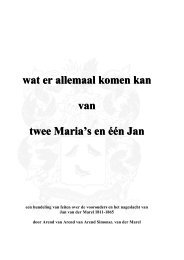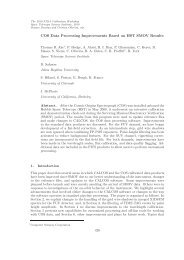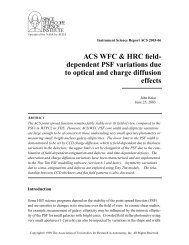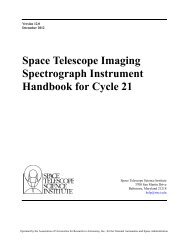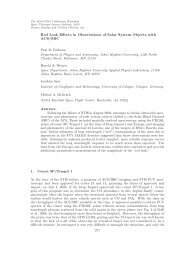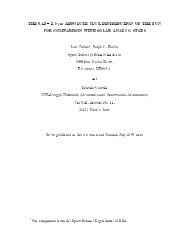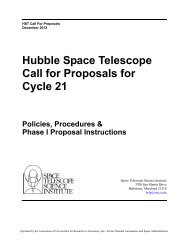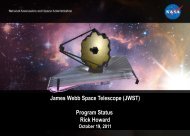STScI Annual Report 2002: A Living Mission
STScI Annual Report 2002: A Living Mission
STScI Annual Report 2002: A Living Mission
You also want an ePaper? Increase the reach of your titles
YUMPU automatically turns print PDFs into web optimized ePapers that Google loves.
48 achievements<br />
Prior to the re-plan effort, the Institute submitted a revised proposal for developing the S&OC that<br />
reduced its costs significantly by using government-provided commanding software and communications<br />
services. In addition, the Institute will delay the development of the JWST ground system until after the<br />
next Hubble servicing mission. Although the Institute will not play a major role in the early development<br />
and testing of the science instruments and the spacecraft avionics, we will complete the S&OC system in<br />
time for end-to-end testing with the completed spacecraft in 2009.<br />
The Institute had originally proposed a National Virtual Observatory extension to the JWST archive.<br />
That work is now postponed until several years after launch. With this exception, the revised observatory<br />
should provide the full scientific capabilities of JWST to the astronomy community.<br />
The Independent Detector Testing Laboratory (IDTL, a collaboration of the Institute, the Johns<br />
Hopkins University, and a number of ground-based observatories) accomplished several milestones in<br />
<strong>2002</strong>. NASA funded the IDTL to test and verify independently the low background performance of near<br />
infrared detector technologies for JWST.<br />
In June <strong>2002</strong>, the IDTL demonstrated its low-background capabilities with a 1 K x 1 K HgCdTe imager,<br />
obtaining dark currents of less than 0.02 e - pixel -1 sec -1 . The lab joins the very small list of facilities that<br />
are capable of testing such devices in the challenging operating regime of JWST. The lab team completed<br />
a suite of performance tests on the 1 K x 1 K and 2 K x 2 K HgCdTe devices and demonstrated the ability<br />
to operate the readout portions of similar InSb devices, which will become available in 2003. The IDTL<br />
test results will help NASA and the Principle Investigators decide in November which technology will be<br />
used on JWST. Within the constraints of the ITAR (International Trade in Arms Regulations), the IDTL<br />
makes its test procedures and results available to the astronomical community for independent review<br />
and assistance.<br />
Throughout <strong>2002</strong>, the Institute has supported the NASA JWST Project in public outreach. JWST<br />
exhibits at the semi-annual American Astronomical Society meetings have encouraged hundreds of<br />
interested astronomers to learn about the JWST science mission and the new technologies that enable it.<br />
At the <strong>2002</strong> summer meeting in Albuquerque, the Institute unveiled a new exhibit featuring a sunshieldinspired<br />
tent and a large science mural capturing the NASA origins theme. The public-oriented website<br />
and the astronomer-friendly website now reflect the mission’s new identity, the new JWST architecture,<br />
and the selected instrument teams and members of the Science Working Group.<br />
Goal 3: Operate a world-class data archive<br />
We will continue to run the best astronomical data archive in the world, adding new data sets, providing new<br />
research tools, and collaborating with other data centers to provide an international astronomy data system.<br />
The Multimission Archive at Space Telescope (MAST) is one of the world’s best and most widely used<br />
data archives. It offers users convenient search and retrieval utilities that access data from 17 missions<br />
and surveys, including Hubble. Even as MAST’s data holdings have grown to over 15 terabytes, our<br />
data retrieval rate regularly exceeds our ingest rate. This high demand is a tribute both to the value the<br />
community places on these data and the success of our efforts to make archival research easy and<br />
scientifically productive.<br />
To keep MAST on the cutting edge, we strive to improve the key functions of a modern archive. We<br />
ensure the preservation of astrophysical data into the indefinite future with reliable storage technologies.<br />
Our scientific and technical expertise guides the processing, re-analysis, and interpretation of the data<br />
holdings. We develop multimission analysis and support tools. We define data, software, and access standards.<br />
We coordinate with other national and international data centers to enhance inter-archive communication.<br />
When investigating the physical processes in the formation and evolution of stars, galaxies, and<br />
large-scale structure, astronomers use data from a wide range of the electromagnetic spectrum. The<br />
MAST holdings—ultraviolet, optical, and near-infrared images and spectra—are a key resource for<br />
these investigations.<br />
In <strong>2002</strong>, we undertook to expand access to important astrophysics data holdings, increase the<br />
productivity of our user community, make it even easier to access data, and enhance the scientific value<br />
of our data.



